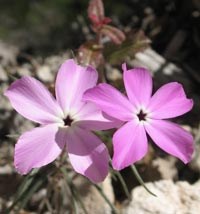
NPS Photo - Cookie Ballou Precipitation patterns, in combination with duration and abundance of moisture in the southwest determine not only blooming periods for wildflowers, but also whether or not one can expect to see flowers in limited quantities and locations, or a sea of vibrant colors splashed across the landscape. The hottest deserts in the southwest – the Sonoran and the Mohave – are famous for their early spring wildflowers, because they often receive reliable rains in winter. About every ten years or so, perfect conditions allow wildflower seeds to germinate by the billions and create an outstanding wildflower show that blankets hundreds of thousands of acres of otherwise sparsely-coated desert. The Chihuahuan desert on the other hand, rarely receives any significant precipitation in winter or spring. Because of the dry nature of these seasons, particularly spring, this cooler and higher-elevation desert favors not annuals but perennials, cacti, succulents, and shrubs. Spring wildflowers in the Chihuahuan desert generally bloom later than those of the Sonoran or Mohave deserts, and tend to be ground-hugging perennials that hide among the rocks, grasses and other plants. This important adaptation not only helps protect them from predators, but also secures them from detrimental weather elements such as damaging winds or a late season freeze. Though the desert is rich with diversity, many varieties that bloom right under foot go unnoticed because of their inconspicuous nature. Flowers that are most appreciated are often those of the cacti, such as claret cups (April), prickly pears and chollas (May), succulents such as ocotillo (April), and yuccas, agaves, and sotols (May). Visitors also enjoy the flowering trees including Texas madrone, Mexican buckeye, and honey mesquite – all of which are as fragrant as they are beautiful. Immediately following summer "monsoon" rains, a whole new crop of plants begin to bloom, and some will last well into fall. Many of these plants, such as gayfeather and cardinal flower provide important nectar sources for butterflies, bees and other insects. The temperate nature of the desert climate insures that something will be blooming nearly any time of the year. And if your timing is perfect, you may have the opportunity to catch a brief, but spectacular profusion of wildflowers, and one of nature's finest moments. |
Last updated: September 6, 2023
